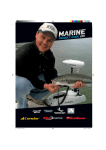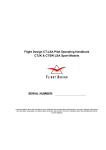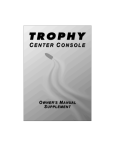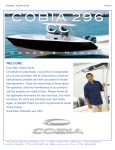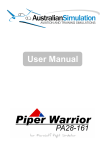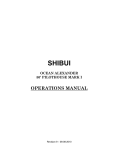Download C90 Owners Manual
Transcript
C90 Owners Manual 1 Switch Off Breaker First Disconnect at Boat Coil about 12” across and stow next to propane locker on aft deck. Never leave hot (breaker on ) a loose cord on dock could shock swimmers If it was to drop in water. The C90 has three main battery switches , House on Off/Off ,Engine On /Off, and Emergency Parallel. The Normal position is to leave both Engine and House switches in the on position. The Emergency parallel is off. Emergency parallel is rarely used as the boat has a Blue Seas Voltage Sensitive relay (black box above switches that disconnects the house batteries from the starter battery when the voltage on the start battery drops below 12.7 volts. As soon as the charge system has brought the start battery back up to 12.7 volts it reconnects the house battery bank and begins charging it automatically. The batteries have three charge sources, First, 2 ProMariner Chargers (8 amp engine, 20 amp house) that come on when shore power is connected and breakers at dash are switched on. Second two 80 watt solar chargers (10 Amps) while anchored-automatic, third a 125 Amp engine driven alternator. Thruster Battery Switches, These are mounted above the main battery switches and are normally on. These must be switched off when swimmers are in the water or for service. The thrusters are very powerful and will suck objects in the water toward them. Do not operate for more that 30 seconds at one time or motor may over heat. The C90 fuel system includes two filters and a electric switching valve at the dash. In normal operation there is no owner/operator activity other than to inspect the Raycor Filters clear glass bowel for water (clear liquid) and drain in to cup through petcock at bottom if present. If the boat has set unused for several days the primer plunger on the white Cummins filter housing should be pressed 8-10 times or until it gets hard, this speeds crank/starting. This plunger will also be needed to prime should you run out of fuel. Raycore uses a 10 Micron 500ser diesel filter. Fuel Tank Switch is located to the left side of dash. Its is labeled Main and Aux, Main is the engine side tank, Aux is the port tank. Depress toggle for tank desired. You typically will run on one tank for 3 hrs then switch so tanks drop equally while underway. Each tank is 40 gallons approximately 36 is usable. With full fuel at 14Kts you should have approximately 16 Hrs running time. This switch also swaps the engines fuel return lines at the same time. Engine room inside wall Always On 12V power breaker is just inside engine room door. It is shown here with flipper tang tucked up this is ON position. Depressing the red plunger will turn it off. Its important to leave this on except for service as it supplies power to the boats 6 automatic bilge pumps and other devices that need power to save memory settings. It is not affected by battery switch position. After each engine service be certain to check this breaker has not been bumped off. If it is off there is no bilge pump protection for leaks. Here the full time power breaker is OFF, (flipper tang down) for service only or to reset electronics or Note: on recent boats this furnace. is a RED 50 amp fuse in the same location. The Cummins QSD 2.0 liter engine uses premium 15-40 oil. It’s best to check oils prior to use. Be carful not to spill or overfill. Change oil and filter when new at 50 hrs then every 100 hrs after. The Twin Disk Transmission uses 30 wt motor oil for its gear lubrication and to engage its clutch. Check oil engine warm/off within 2-3 minutes of shut down. If the oil is low the clutch will drop out and the boat will stop-find leak-refill. To top off, it’s easiest to fill through the dip stick opening with supplied funnel check frequently while filling as overfilling can damage the transmission. Change after 50 Hrs and then every 100 hrs, clean wire mesh filter. This Blue Seas Systems unit separates the house batteries from the start batteries automatically when the house voltage is bellow 12.7 volts. No user activity is required. Engine Room Inside wall Battery Chargers These ProMariner automatic chargers are wired to come on when the boats shore power is connected and the A/C breakers at the dash are switched on. The chargers are 4 stage smart units that charge aggressively if the battery is low and then ramp down as it fills. They then drop out completely when full and then do a small topping charge weekly. The design greatly extends battery life and over charging and subsequent battery damage. Check battery water levels monthly ,lower water levels/ exposed plates will damage the batteries lead plates requiring replacement. Engine Room Fwd Wall There are two raw water valves on the boat both in the Starboard Lazarette (inside hull side fwd). The smaller one ½” is for the head and the aft deck wash down. The larger one 1.5” is for the engine cooling water. Raw Water Valve OFF Raw Water Valve On, 45 degrees ½ Inch raw water valve is run typically at 45 degrees to reduce its pressure while underway and stop head overflow. These valves are typically left on as running the boat with valves closed will damage the engine and impellers. Engine Cooling Water Ball Valve Off Engine Cooling Water ON Be sure to close valve when cleaning the raw water strainer House Batteries 2ea G27 Deep cycle, wet lead acid, 4” water lift muffler to left, drain muffler when stored for winter with drain bolt at bottom, resilicone bolt after. Engine start battery G27 (Center), Teliflex SeaStar hydraulic steering ram. Note: Rudder packing should be retightened/checked with each oil change. Drip-Less shaft seal oil reservoir, keep ½ full with ATF type transmission fluid (automotive type). If it is using fluid it is very likely time to change the three oil seals on the prop shaft. Boat must be out of water to do this service. Oil will discolor/darken some with use. Tip out Bin on early Boats/New boats have box in Port Cockpit storage locker. Note: Locker is plumbed with a hose to a through hull overboard so a gas leak would not inter the boat. If you ever smell gas stop-turn off valve and open boat to clear fumes. Find leak. Electric shut off valve only comes on if gas controller by sink is on and sniffer smells no gas. To use, make sure hose connection is tight, open valve, gauge will show aprox 90 Psi. If you hear a hissing or smell gas turn valve off ,check connections. 15 pound tank will typically last 2+ weeks. Re-Installing gas box lid is easier if tip out bin is part way closed. The tank must be centered in compartment to latch lid in place. 6 Gallon Seaward Hot water heater SS. Runs on 120 V while at dock. Note it draws 2000 watts so you will not be able to run large additional loads while water heater is on. Switch its breaker on only when hot water is needed. While cruising the engines hot water is plumbed through the heater to heat water. 28 gallon holding tank (black water) This tank as are both water tanks are equipped with a density sensor gauge system located to right side of dash, press right hand button to check holding tank level. If tank is full the head will not flush. You must be 3 miles off shore and in a area with current that will flush to use the macerator switch at dash. Note :shut boat off to hear change in tone when tank is empty, running pump dry will damage its rubber impellers. The tank can also be emptied at a pump out station using the fitting near the transom door. The tank includes two dip tubes so there is no YValve to switch. Pressure Water Pump and Strainer: The C90 has two water tanks (24 gallons port side and 26 gallons Starboard side) each has a dedicated pump. The fresh water pump switch is located on the dashes lower DC switch panel. Two tanks are provide so owners can use water to trim the boat port to starboard if needed. It like fuel is a heavy cargo, top off only if you need it. Water Tanks must be drained and system primed with RV antifreeze during winter storage. Stow fenders and dock lines in port aft compartment Switch on Engine Blower, a cool engine is more efficient. Fill Water tanks as needed (port and starboard) Cockpit fwd walls. Be sure water is good ,taste it! Ask fellow boaters. During long inactive periods ad a little chlorine to keep fresh. Switch on Refrigerator, lower left DC panel. The propane control unit is just fwd of the sink. This units power may be switched at the dash on early models. When stove is not in use tap the control button and turn the gas off . Green light When Power is on but unit is off Gas is on when the Red Light is ON. DC Panel: This panel is fed from the house batteries . It includes both voltage (pressure gauge) and Amp gauge (volume) to manage your power during the day, reducing amps used is most important to extending battery life. While boating turn all the breakers on as shown. The small silver toggle switch will show battery voltage engine (left #1) and House (#2 center), #3 is not connected as we have only two battery banks. These breakers then feed both dash DC switches panels and the fuse blocks for electronics and pumps. A DC shunt is standard for the amp meter. AC Distribution Panel: This panel is fed from the 30 Amp shore power connection. Typically, all the breakers but the hot water heater are left on energizing the boats outlets. If you see the red reverse polarity light lit (2nd bulb down) see your dock master before continuing some boat systems could be damaged. Turn on hot water only when needed. Both panels are Blue seas systems premium panels. The Sensa Tank display reads tank levels with very reliable density sensors bonded to the out side of each tank. To read tank level: Press button #1 for Port water tank, Press #2 for Starboard tank Press #3 for Waste tank (black water) Solar Panel Charge Controller: The Solar Boost 2000 is a premium charge controller that helps capture all the suns peak mid day energy. The unit is automatic and requires no operator input as the battery's become fully charged it automatically ramps down its charge so batteries are not over charged. It also automatically shuts down if it sense another charge source (engine or battery chargers) The slide switch is useful to see battery banks volts and current input. Note: If it seems not to be charging while out, the batteries maybe full or the Kayaks are blocking the sun. If batteries are low and the sun is bright the unit will put out up 11 amps. Thrusters: these Side Power units are very handy while docking. Once battery switches are on depress both ON buttons at the same time, green light will come on. Now the joy sticks are ready press bow stick left boat goes left. Use in 20-30 second bursts never more than 3 minuets of use to keep motors cool. Be certain no one is in water near boat the thrusters work like vacuum cleaner sucking from a large area. Unit shuts off automatically after 3 minuets of inactivity. A wireless remote is available for solo docking. Icom VHF Radio. To turn on rotate top right knob, most conversations with other boaters will be on low power, use Ch 16 only for hailing ,then switch to 72 or 68, weather also available by pushing WX button. Lower Knob is squelch use it to turn down background static. Wiper Motor –Washer Control, These are on left side of dash, two speed push to wash, Wash tank is in back corner of storage bin behind refrigerator under helm seat you will have to remove safety gear for access. Rain – X works great on front and side windows to aid in visibility STARTING ENGINE: Once batteries and blower are on you can start, engine (starter will time-out after 20 seconds), switch off-re crank. If motor does not start open engine room door and push primer plunger on white fuel filter until hard, then restart. Important you must warm engine up slowly over 10-15 minuets at RPMs under 2,000 prior to running at cruise RPM Do not go above 2,000 Rpm until motor has reached 176 degrees. 80% of engine wear is while motor is cold. Safety Gear Storagemanuals Engine Computer: This is a very useful instrument. Toggling the propeller button shuttles you to a variety of data. It’s fine to push the boat and horizon button for additional information. Oil pressure while running will be about 90 Psi, water temperature will be about 176-180. If you hear a horn or beeping while underway you must stop and determine the cause. Engine manuals are under helm seat in blue bag. Pumps Panel: This panel controls the boats bilge pumps and shower sump pump. Most of these are automatic but these switches allow you to turn each of the 6 pumps for each water tight compartment on manually. Other than fresh water these switches are normally in the off position . This panel is fed from the pumps breaker on the DC main panel. The automatic portion of the bilge pumps is not affected by this panel. Note: The engine room has a 7th pump (1100GPH emergency pump) this pump is wired to a very loud horn behind the dash. Should you loose an engine hose and begin to fill the engine room this pump and horn will come on automatically. Ships Systems Panel: This panel includes navigation lights, blower and many other ship systems. It is also fed from the main DC panel breaker. At dash center. These panels have separate automotive blade fuses under the plastic snap cover ranging from 520 amps. If a fuse has blown determine cause possibly debree in pump ,shorted wire . Fix then replace fuse. To access fuses careful ly pop grey cover off with tape wrapped dinner knife or flat blade screw driver-pull rubber gasket over fuses and replace fuse. The C90 is equipped with large trim tabs. This tabs are primarily used to trim the boat for maximum efficiency and comfort while cruising. Due to their size and positioning, they can lift a great deal while creating very limited drag. Typically after setting for a given throttle RPM you will level and trim down to find the maximum speed for that RPM. If the seas are choppy you may find that less trim is a softer ride and dryer. Use your discretion . I find in 0-12” seas full tabs is often most efficient and a good ride. In 12-24” seas you will need to reduce tabs to 2/3 or less and let the bow float through the seas. In larger seas you may find no tab is best. Please note your best ride in heavy seas will often be at 14-17Kts. If the boats bouncing or thumping try something different. Zero Tabs: Used for large seas 14-20 Kts ½ Tabs used in 2-3ft seas 14-20 Kts Full Tabs used in 0-1 ft Seas 14-17 Kts Note: Retract tabs when not in use to protect actuator shaft from marine growth – barnacles. First mixer is set to temp, The sink wand lifts to hanger near door, curtain from shelf behind door is snapped into ceiling buttons, auto sump pump under head evacuates water. Dry door and shower area when done. Door can be left open or closed when showering. Note: Boat showers are recommended to conserve water. IE get wet, turn off, soap up, rinse off. Sprayer has three positions, Off, On with button, On full time. Meguiars Marine Boat Soap with wax, keeps boat wax intact, great for gel coat. Meguiars Flagship Wax, This is a premium wax and UV protectant. Hand wax once per year in Northern climates, twice in southern. Wax both deck and hull. In the south, even the non skid maybe waxed with a brush. T-9 Bowshield, This is wonderful for your engine rooms metal parts, all of them, bronze, SS clamps, Cummins metal parts, battery connections, bonding system connections, Honda 2hp . Keep away from plastic, and belts. Light re-coat every 6 months. Wipe up any excess while wet. 303 Aerospace Protectant, This material is for plastic that’s out in the sun, I.E. Vinyl seats, Zodiac boats, recoat every 3 months. The Wallace furnace control is located to the left of the helm, to turn on push toggle switch to right and rotate fan-heat control knob to desired level. The controller has no thermostat due to size of space heated. The unit is located under the sink. Note: When first warming up, it may howl for a few moments, adjust speed to stop. During its first operation, it may time out as the fuel pump did not prime, -restart unit. Note: If a vent is not flowing, pop grill off, twist valve inside open. The vents are located in the salon, at the dash and in the master stateroom. Do not block the flow as this will shut the unit down from overheating. There is a boost fan for defrosters, switch it on at DC panel to left of helm. We have found at times on the lowest flow setting it may shut off after 4-6 hrs. To reset, trip the constant hot power breaker in the engine room and then reset breaker on. To Start, push and hold power button at top right for three seconds. Unit will come on in 10 seconds. Next press Charts Next Press Navigation Charts Screen will come up with chart and data fields. To zoom in or out press + or -. To change page to sounder press home button and toggle to desired page. Note :To dim unit at night tap power button and use active button to adjust light level. You must turn back up when done or the screen will be black the next day, very hard to see buttons. Tilt Helm, lever under wheel, hydraulic fluid (Teliflex) fills at top, under rubber boo Running attitude, 16 Kts tabs down Master Curtain snap in, labeled Port - Starboard ,arrow shows Fwd. Roll and store in headboard bookshelf. Start While folding be carful not to lean on Solar Panel glass, rest support tube carefully on SS Mast, tip in to cockpit, then lift forward to corner for towing. Note: It’s best to close door before placing support. Done Each of these 4 fuse blocks are dedicated to a specific system and are powered by a dedicated breaker at dash or in engine room. Hot Float (8 gang right) Electronics (6 gang top) House equipment (6 gang middle), House lights (6 gang bottom) Black box to right of helm is Blue seas dimmer for dash lights. Fuses 3amp-20amp, most 5-10 amp. 300 Watt 12V to 120V inverter for lap tops and charging phones , Carbon monoxide detector standard. Fuse Panel located behind dash under helm station. Aspens Trailer is built by Float On Trailers in Vero Beach Florida. It is a 10,000 pound capacity aluminum trailer. The minimum tow truck size is ¾ Ton. When the ball weight is set to 6-7% of the towed weight (600-800 pounds) she tows like a dream. Includes a solid winch stand assembly with stair for access while loading. Show are the optional mag wheels and electric hydraulic breaks (nice for hilly terrain and backing up steep driveways. The design is self centering and loads under power to the winch stand. Show are the guide bunks, Note: when off loading the fenders will typically be 8-10” underwater. On west coast ramps the tow truck tires will typically be at the waters edge. On east coast ramps which are steeper you will back in less to get the correct depth. Shown is the keel capture and guide pads to center hull as it pulls out of the water. Be sure tires are inflated to within 5 PSI of the recommended capacity. Check bearing and tire temperature with a touch at each fill up. Increased temperature is a sign of bearing problems, low air pressure will heat up the tires. Arrows show location of the lifting straps. On the stern the goal is to lift on the keel (Fiber Glass) about 6” forward of the Stainless Sand Bar. Be sure to preload the starboard side as tension is brought up by pulling the cross bar down closer to the deck/engine load (approximately 10”.) This will keep the boat level as it lifts The forward Sling goes just forward of the port light well clear of the thruster. The cross bar is typically level for the bow. Note: If you lift one end at a time to put blocks in to place the straps be sure to block the trailer frame to support it or you will bend the frame. The Simpson Lawrence windless mounted on the front deck has power controls at both the helm and front deck for ease of use. The unit uses ¼” chain typically 40’ and 250’ of ½ “ line typically triple braid that’s been woven to the chain. The capstan can handle both chain and line, transitioning automatically as the line move through. When the line is new it’s often a good idea to remove the anchor at its swivel and run the line up and down 2-3 times to clear any kinks in the line The Windlass has a friction clutch built into the capstan. Its tension is adjusted by inserting the wrench in the box socket and tightening clockwise for more friction counterclockwise for less (wrench is in owners briefcase). This is a delicate procedure as to little tension and the clutch slips when lifting under-load. To much tension as the anchor comes up into the roller assembly it can be bent. When the anchor rode has been purchase from Aspen it includes depth markers every 30 ft to aid in anchoring. The Windlass Breaker is located in the master staterooms hanging locker just forward of the bow thrusters service hatch. Note the anchor line end must be secured to the bitter end cleat in the anchor locker. Be sure to secure the anchor up with a bungee or line when underway. Line after Stacking-detangle Anchor with snubber bungee Windlass Wrench Anchor Depth Markers Kayak with ratchet straps and foam pad. Be sure to remove Kayak while towing Electrical junction box Tender Snubber line for medium range towing to take wind buffeting out. Long hauls it is best to deflate tender. Line also used to lower-raise tender. Store Rods on transom clip Un-clip SS support rods Tip Tender in, leave clipped to boat while mounting motor. Support Engine on swim step, step into tenderswing engine to transom Un buckle engine in Port laz. Tighten Screw clamps aggressively. Rinsing engine with hose


































